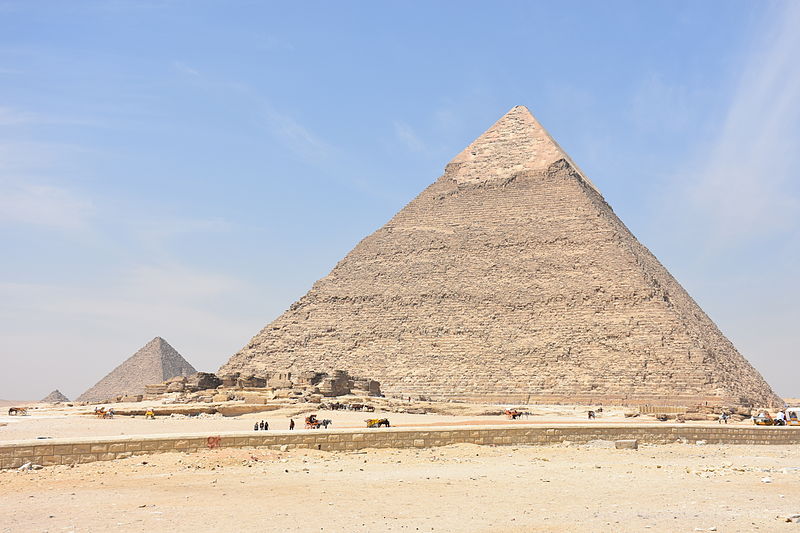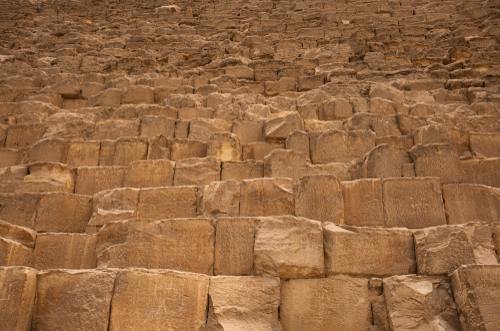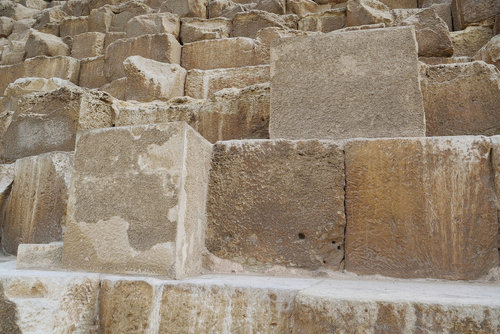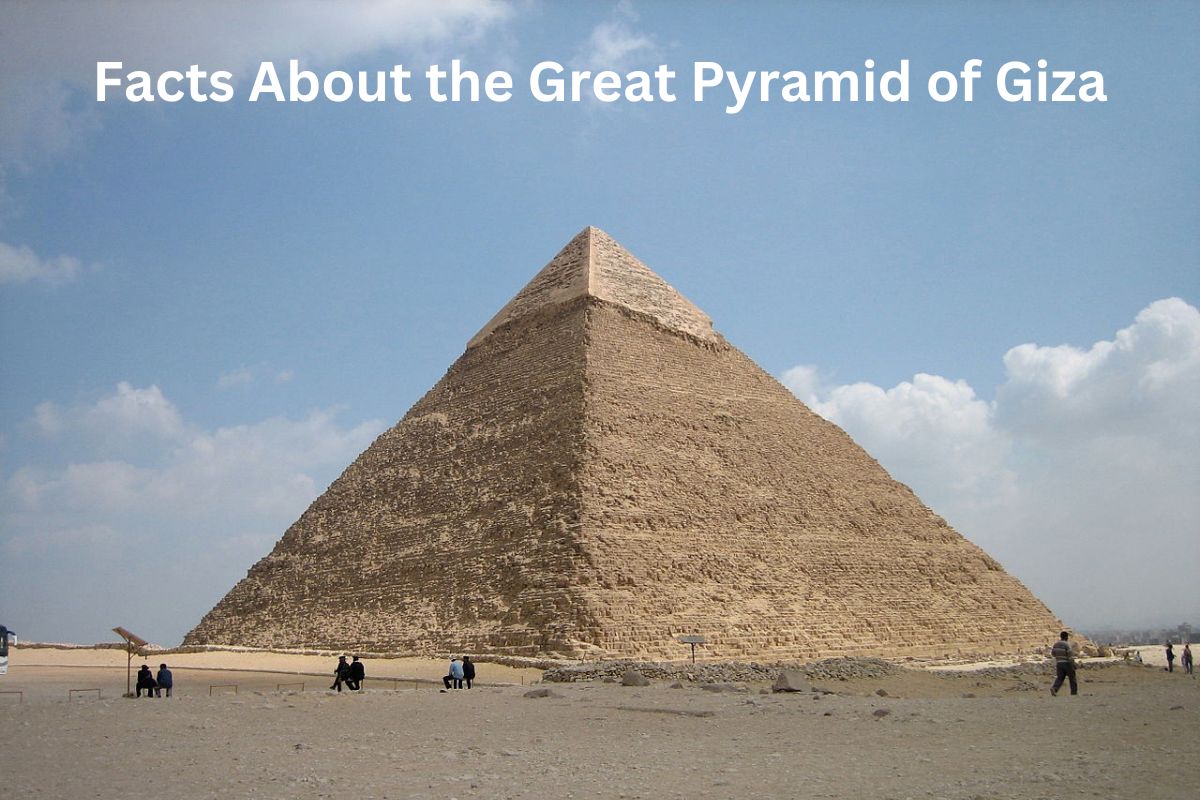The Great Pyramid of Giza, also known as the Pyramid of Khufu or the Pyramid of Cheops, is an ancient marvel that has stood the test of time.
Located on the Giza Plateau near Cairo, Egypt, this awe-inspiring structure is the oldest and largest of the three pyramids in the Giza pyramid complex.
Built during the Fourth Dynasty of the Old Kingdom of Egypt, around 2580-2560 BCE, the Great Pyramid is over 4,500 years old and is the only surviving monument of the Seven Wonders of the Ancient World.
Today, the Great Pyramid, along with the other pyramids of Giza and the Great Sphinx, attracts millions of visitors each year, making it a significant archaeological site and one of the world’s most iconic tourist attractions.
Great Pyramid of Giza Facts
1. “Khufu” and “Cheops”
The Great Pyramid of Giza is also referred to as the Pyramid of Khufu or the Pyramid of Cheops.
The names “Khufu” and “Cheops” refer to the same Egyptian pharaoh, with Khufu being the original Egyptian name and Cheops being the Greek rendition.
Also Read: Khufu Accomplishments
Pharaoh Khufu, who ruled during the Fourth Dynasty of the Old Kingdom of Egypt, commissioned the construction of this magnificent pyramid as his tomb, reflecting his power and prestige.
2. It is oldest and largest of the three pyramids

The Great Pyramid of Giza is the oldest and largest of the three pyramids in the Giza pyramid complex. Situated in Giza, Egypt, near the bustling city of Cairo, this monumental structure has a history dating back more than 4,500 years.
Constructed during the Fourth Dynasty of the Old Kingdom of Egypt, around 2580-2560 BCE, the Great Pyramid was a testament to the architectural and engineering skills of the ancient Egyptians.
Also Read: Facts About the Sphinx
The other two pyramids in the Giza complex belong to Pharaoh Khufu’s successors: the Pyramid of Khafre (or Chephren), which is slightly smaller than the Great Pyramid but appears taller due to its elevated position on the plateau, and the Pyramid of Menkaure (or Mykerinos), the smallest of the three.
The Giza pyramid complex, with its rich history and stunning architecture, continues to be a significant archaeological site and a major tourist attraction, offering visitors a glimpse into the fascinating world of ancient Egypt.
3. The pyramid has been subject to erosion
The Great Pyramid of Giza was originally 146.6 meters (481 feet) tall when it was first constructed.
Over the centuries, the pyramid has been subject to erosion, and the outer casing stones made of polished white Tura limestone have been removed or repurposed for other construction projects.

As a result, the pyramid’s current height is 138.8 meters (455 feet), slightly shorter than its original height.
4. The Great Pyramid of Giza covers an area of approximately 13 acres
The base of the Great Pyramid of Giza covers an area of approximately 13 acres (5.3 hectares). Each side of the pyramid measures around 230 meters (756 feet) in length, making it a massive structure.
Also Read: Facts About the Temple of Artemis
The enormous size of the base and the precise alignment of the pyramid showcase the architectural and engineering mastery of the ancient Egyptians.
5. Three main internal chambers
The interior of the Great Pyramid of Giza features three main chambers:
- King’s Chamber: Located in the heart of the pyramid, the King’s Chamber was intended to be the burial chamber for Pharaoh Khufu. It is constructed primarily of red granite and contains a large, empty granite sarcophagus. The chamber is accessed through a long, ascending corridor known as the Grand Gallery.
- Queen’s Chamber: Situated below the King’s Chamber, the Queen’s Chamber was likely designed for symbolic or ceremonial purposes, rather than as an actual burial chamber for the queen. It remains a mystery as to what its exact function was. This chamber is smaller than the King’s Chamber and is lined with fine limestone.
- Unfinished Subterranean Chamber: Carved deep into the bedrock beneath the pyramid, this chamber remains unfinished, with rough walls and an uneven floor. The purpose of this chamber is unclear, but it could have been intended as a storage area or an earlier, abandoned plan for the burial chamber.
In addition to these chambers, there are several narrow shafts, also known as air shafts or star shafts, which extend from the King’s and Queen’s Chambers towards the exterior of the pyramid.
The purpose of these shafts is still debated among scholars, with some suggesting that they served as ventilation, while others believe they had a symbolic or astronomical significance.
6. It used to look much brighter
The original outer casing of the Great Pyramid of Giza was made of polished white Tura limestone, a material quarried from the nearby hills on the eastern bank of the Nile.
This casing would have given the pyramid a smooth, shining appearance, making it a truly remarkable sight when it was first constructed over 4,500 years ago.
Also Read: The Colossus of Rhodes Facts
Unfortunately, most of these casing stones have been removed or repurposed over time for other construction projects, particularly during the Middle Ages and later periods.
This has left the stepped core structure, known as the “step pyramid” design, exposed. The loss of the outer casing has somewhat diminished the original splendor of the Great Pyramid, but it still stands as an awe-inspiring monument
7. It weigh approximately 5.9 million tons
The Great Pyramid of Giza is estimated to weigh approximately 5.9 million tons. This colossal weight is a result of the roughly 2.3 million stone blocks used in its construction.
The stones used in the pyramid are primarily limestone, with some granite blocks in the inner chambers.

The average weight of each limestone block is around 2.5 tons, but there are larger blocks, such as those used in the King’s Chamber, that weigh up to 80 tons.
The enormous size and weight of these stones demonstrate the impressive engineering and logistical capabilities of the ancient Egyptians, who were able to transport, position, and stack the blocks with remarkable precision to create this iconic monument.
8. The average block weighs 2.5 tons
The average weight of the limestone blocks used in the construction of the Great Pyramid of Giza is approximately 2.5 tons. However, some of the larger blocks, particularly those used in the King’s Chamber and other inner structures, are made of granite and can weigh up to 80 tons.
The fact that the ancient Egyptians were able to transport, lift, and position these massive blocks with such precision is a testament to their advanced engineering, architectural, and logistical skills.
While various theories have been proposed to explain how these massive stones were moved and placed, the exact methods used by the ancient Egyptians remain a subject of ongoing research and debate among scholars.
9. The Great Pyramid of Giza is aligned to true north
The Great Pyramid of Giza is aligned to true north with incredible accuracy, deviating by only about 3/60th of a degree (or 3 arc minutes).
This level of precision is truly remarkable, especially when taking into account the limited tools and methods available to the ancient Egyptians during its construction more than 4,500 years ago.
The reasons behind the pyramid’s precise alignment are still a subject of discussion among scholars. Some suggest that the alignment was intended for religious or astronomical purposes, while others argue that it was a demonstration of the Egyptians’ advanced understanding of geometry and mathematics.
10. It contains a large granite sarcophagus that is empty
The King’s Chamber, located within the Great Pyramid of Giza, contains a large granite sarcophagus that was believed to have held the remains of Pharaoh Khufu.
However, when the chamber was first entered by explorers in antiquity and later in modern times, no human remains or funerary artifacts were found inside the sarcophagus or the chamber itself.
The absence of any remains or artifacts in the King’s Chamber has fueled speculation and debate among scholars and researchers. It is possible that the tomb was robbed in ancient times, and the contents were removed, including any mummified remains of the pharaoh.
Another theory is that the chamber might have been a symbolic or cenotaphic burial site, with the actual remains of Khufu located elsewhere. However, despite extensive archaeological investigations, the precise whereabouts of Pharaoh Khufu’s remains continue to be an enduring mystery.
11. It is the last of the Seven Wonders of the Ancient World
The Great Pyramid of Giza is the last remaining structure of the 7 Wonders of the Ancient World, which were a collection of remarkable architectural and artistic achievements from antiquity.
The other six wonders were:
- The Hanging Gardens of Babylon
- The Temple of Artemis at Ephesus
- The Statue of Zeus at Olympia
- The Mausoleum at Halicarnassus
- The Colossus of Rhodes
- The Lighthouse of Alexandria
These wonders were celebrated for their grandeur, beauty, and ingenuity. Unfortunately, the other six wonders have been lost to natural disasters, wars, and the passage of time, leaving only the Great Pyramid of Giza as the sole survivor.
Its endurance across millennia is a testament to the remarkable skills of its ancient builders, and today it stands as a symbol of the enduring fascination and awe that the accomplishments of ancient civilizations continue to inspire.
12.The construction techniques are still a mystery
There is much debate and speculation about the construction techniques used to build the Great Pyramid of Giza.
Despite extensive research, the exact methods remain a mystery. Several theories have been proposed over the years, which include the use of ramps, levers, and counterweights. Some of the most popular theories are:
- Straight Ramps: One theory suggests that a long, straight ramp was constructed alongside the pyramid, with the stones dragged up the ramp to their final positions. However, the sheer size of the required ramp and the logistics of constructing and dismantling it make this theory less likely.
- Circular Ramps: Another theory proposes that a circular or spiral ramp was built around the pyramid as it was constructed. This would have allowed workers to drag the stones up the ramp, layer by layer, until the pyramid was complete. Some variations of this theory include an internal spiral ramp within the pyramid itself.
- Levers and Counterweights: Some researchers propose that levers, cranes, and counterweight systems were used to lift and position the massive stone blocks. This theory would require advanced engineering knowledge and the use of specialized tools, which the ancient Egyptians are believed to have possessed.
- Water-Based Methods: Another theory suggests that the ancient Egyptians might have used water-based techniques to transport and lift the stones. This could include the use of canals, barges, or even water-filled locks to raise the blocks to the necessary height.
Despite the various theories and ongoing research, there is no definitive answer as to how the Great Pyramid was built.
13. The Giza Plateau is a significant archaeological site
The Giza Plateau is a significant archaeological site and a major tourist attraction, attracting millions of visitors every year. The plateau is home to several iconic ancient structures, including:
- The Great Pyramid of Giza (Pyramid of Khufu): The largest and oldest of the three main pyramids, commissioned by Pharaoh Khufu.
- The Pyramid of Khafre (Pyramid of Chephren): The second-largest pyramid on the plateau, built by Pharaoh Khafre, Khufu’s successor. It appears taller than the Great Pyramid due to its elevated position and the better-preserved casing stones at its peak.
- The Pyramid of Menkaure (Pyramid of Mykerinos): The smallest of the three main pyramids, constructed by Pharaoh Menkaure, Khafre’s successor.
- The Great Sphinx: A massive limestone statue with the body of a lion and the head of a human, believed to represent Pharaoh Khafre. It is the oldest and largest monolithic statue in the world, measuring 73 meters (240 feet) in length and 20 meters (66 feet) in height.
These monuments, along with several smaller satellite pyramids, tombs, and temples, make the Giza Plateau an incredibly important archaeological site that offers invaluable insights into the culture, history, and architectural achievements of ancient Egypt.
The plateau’s proximity to the modern city of Cairo also makes it easily accessible to visitors from around the world, adding to its popularity as a tourist destination.
